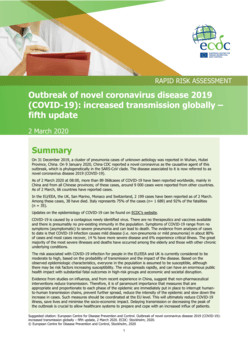Hello! You're looking at a policy document report on Overton
We track government policy, guidelines, think tank research, working papers and more to help our customers see the impact and influence of their work. Are you interested in seeing what information we have to offer? Request a free trial to our platform.
If you fund, produce or manage research or work to influence policy, we'd love to talk. Learn more on our homepage.

Identifiers
Overton ID
ecdc-249476e603c16cfe6367c5d9ba8bde73
Rapid risk assessment: Outbreak of novel coronavirus disease 2019 (COVID-19): increased transmission globally fifth update
As of 2 March 2020 at 08:00, more than 89 068 cases of COVID-19 have been reported worldwide, mainly in China and from all Chinese provinces; of these cases, around 9 000 cases were reported from other countries. As of 2 March, 66 countries have reported cases. The risk associated with COVID-19 infection for people in the EU/EEA and UK is currently considered to be moderate to high, based on the probability of transmission and the impact of the disease.
Topics in this document
Social distancing
Infection
Influenza
Middle East respiratory syndrome-related coronavirus
Transmission (medicine)
Blood donation
Health care
Influenza-like illness
Public health
Disease
Surgical mask
Risk management
Risk
Clinical medicine
Medical specialties
Medicine
Health sciences
Health
Infection control
Virus
2019–20 coronavirus outbreak
Emergency department
Epidemiology
Hygiene
Medical humanities
Coronavirus
Business continuity planning
Diseases and disorders
Pandemic
Severe acute respiratory syndrome-related coronavirus
Related SDGs
SDG 3: Good Health and Well-being ...
SDG 3: Good Health and Well-being
Target 3.3
End the epidemics of AIDS, tuberculosis, malaria and neglected tropical diseases and combat hepatitis, water-borne diseases and other communicable diseases
Target 3.d
Strengthen the capacity of all countries, in particular developing countries, for early warning, risk reduction and management of national and global health risk
Cites research funded by
1
Sun Yat-sen University
1
National Natural Science Foundation of China
1
NSFC
1
Sanming Project of Medicine in Shenzhen
1
National High-tech Research and Development Program
1
Science and Technology Planning Project of Shenzen Municipality
1
Government of the Hong Kong Special Administrative Region
1
Terumo BCT
1
Terumo
1
Swiss National Science Foundation
1
ESRC January 2022
1
MRC
1
ESRC
1
NIHR (November 2024)
1
Economic and Social Research Council
1
National Institute for Health Research (NIHR)
1
Wellcome Trust
1
Medical Research Council
Citations
Cited by 48
other policy documents
(34 of them are from other policy sources)
